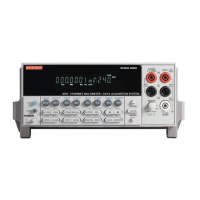3-34 Basic DMM Operation Model 2701 User’s Manual
When you connect a thermocouple directly to the input of the Model 2701, at least one of
those connections will be a junction made up of two dissimilar metals. Hence, another
voltage is introduced and is algebraically added to the thermocouple voltage. The result
will be an erroneous temperature measurement.
To cancel the affects of the unwanted thermal voltage, the thermocouple circuit requires a
reference junction that is at a known temperature.
Reference junctions
A reference junction is the cold junction in a thermocouple circuit which is held at a
stable, known temperature. It is at the cold junction where dissimilar wire connections
must be made. As long as the temperature of the cold junction is known, the Model 2701
can factor in the reference temperature to calculate the actual temperature reading at the
thermocouple.
The standard reference temperature is the ice point (0°C). The ice point can be precisely
controlled and the National Bureau of Standards uses it as the fundamental reference for
its voltage-to-temperature conversion tables. However, other known temperatures can be
used.
There are two ways for the Model 2701 to acquire the cold junction temperature. It can
measure the cold junction using a thermistor or 4-wire RTD or the known temperature
value can be entered by the user.
There are three reference junction types supported by the Model 2701: simulated
reference junction, internal reference junction, and external reference junction. These
reference junctions are explained in the following paragraphs.
NOTE When using multiple channel operation (ROUT:MULT command) to connect a
switching module input channel to the DMM, the SIMulated reference junction
will be used if the INTernal or EXTernal reference junction is selected.
Simulated reference junction
An example of a simulated reference junction is an ice bath (Figure 3-14A and B). The
copper wire to thermocouple wire connections are immersed (but electrically isolated) in
the ice bath, and the user enters the 0°C simulated reference temperature into the
Model 2701. The simulated reference temperature for the Model 2701 can be set from 0 to
65°C.
The Model 2701 measures the input voltage and factors in the simulated reference
temperature to calculate the temperature reading at the thermocouple.
NOTE The most accurate temperature measurements are achieved by using a simulated
reference junction using an ice point reference.

